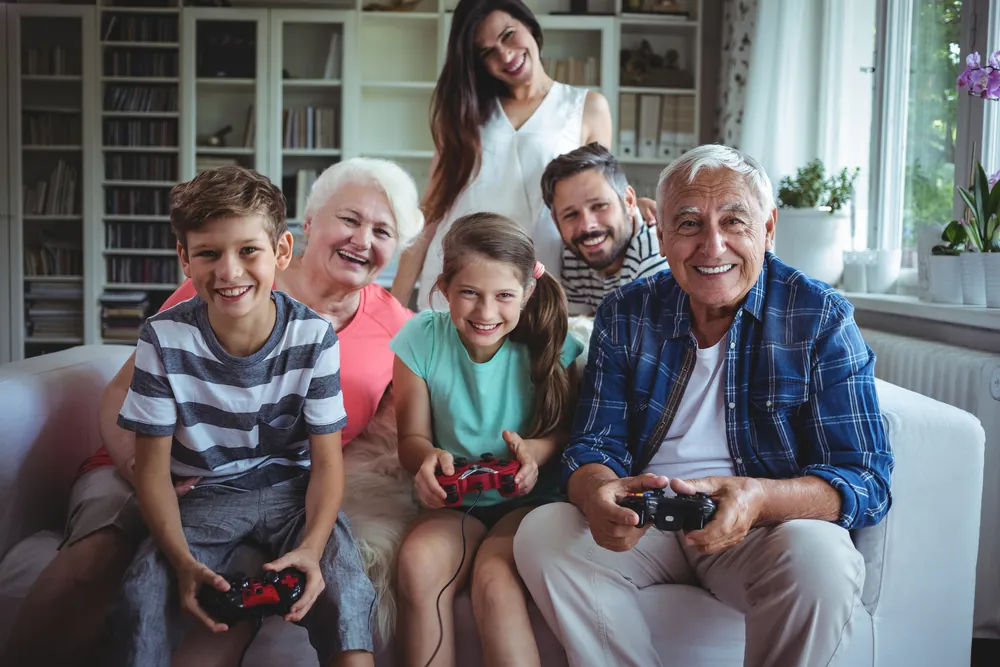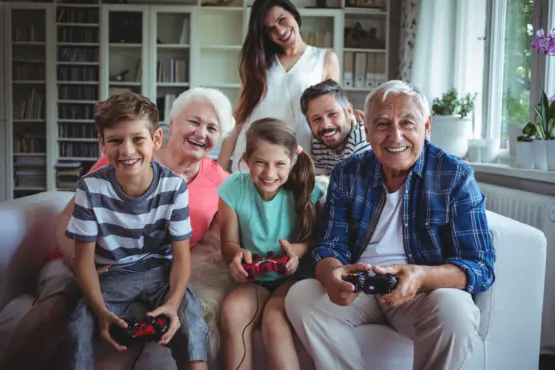Contrary to certain sensationalist articles declaring that video games are harmful, there is, in fact, growing evidence that playing video games may have a positive effect on cognitive health, particularly in older people [1].
Today, we will be taking a look at the scientific evidence to see if brain training or hitting your favorite video game titles could help keep you healthy as you age.
Could playing video games be a useful part of a health and longevity strategy?
Studies have already shown that video game training can improve a number of cognitive functions, including memory, reaction time, cognitive control, attention span, and the ability to multitask, including in young adults [2-6].
The data suggests that complex, three-dimensional video games may improve hippocampal-associated memory, which is performed by the part of the brain responsible for the storage and recall of declarative memories [7]. Declarative memory is the memory of facts and events and refers to memories that can be consciously recalled (or declared).
Scientific studies also suggest that playing video games may improve posture, balance, and muscle strength [8-10]. This is particularly relevant for older adults who are at greater risk of falls and resulting injuries while generally helping to combat sarcopenia and the frailty it brings.
Online gaming takes things a step further
With the prevalence of online video games, we see a fusion of mental, physical, and social aspects [11]. Players all over the world share online worlds together, participate in group activities, such as battles and quests, and compete with each other in contests of skill. These games go beyond the simple entertainment concepts of video games and explore many vistas of human experience.
The meteoric rise of eSports in recent years has seen a shift away from video gaming simply being for personal entertainment, and it is now watched by millions worldwide in the same way as traditional sports, such as football, baseball and so on [12]. Video games such as Starcraft 2, Overwatch, League of Legends, Dota 2, and CS:GO have a dedicated eSports network, with rosters of professional and semi-professional teams competing in leagues for cash and prizes, just as traditional sports games have. eSports involve a complex network of social, physical and mental interactions that previous video game culture did not encompass [13]. It might be useful to study the long-term effects of being an eSports player and its impact on health.
Massive multiplayer online games (MMOs), such as World of Warcraft, Guild Wars 2, Neverwinter, Elder Scrolls online, and Eve Online, are also very popular and bring together many social aspects as well as the regular physical and mental ones that video gaming demands. The players of these games inhabit persistent online worlds that evolve and change as players interact with them, and they encompass a microcosm of social conventions, economies, and shared experiences.
Online communities are communities of practice
These games are essentially communities of practice where players compete and cooperate in a manner that goes way beyond simple gaming for entertainment [14-15]. A community of practice is formed by people who engage in a process of collective learning in a shared environment, such as a tribe learning to survive, scientists working on a shared problem such as aging, a group of doctors sharing novel techniques, company managers sharing best practices, and, of course, online video gaming communities learning and developing new skills and strategies.
Given that socializing is well documented as being an important key to aging and longevity, one has to wonder what impact such social gaming might have on aging [16-17]. We know that socializing via social media versus physical socializing is markedly different in terms of the response it produces in the brain, with direct physical interaction being much more beneficial and protective against the effects of social isolation [18-22]. However, social media is fairly static and nowhere near as dynamic as these online gaming communities are, so perhaps future studies will map these social interactions and their effects on the brain and compare them with face-to-face socializing.
Another aspect of exposure to these communities of practice is that an older player has the opportunity to learn and develop new skill sets as part of regular interactions. Not so long ago, video games were traditionally considered the domain of the young, but with the aging of the original video gaming generations born in the 1970s and 1980s, it is common to encounter middle-aged or older players on a frequent basis in online games today.
These older players can benefit from these communities of practice just the same as younger ones, and they may develop skills and cognitive abilities that they could also find useful in life outside gaming, such as problem-solving and teamwork abilities that could be potentially applied to real-world situations [23].
Conclusion
So, perhaps picking up your controller and playing the latest video game title, or even better joining your friends for some online gaming could be a helpful longevity measure; just make sure you mix it with physical activity and take plenty of breaks while gaming to avoid being sedentary.
Finally, perhaps the best of both worlds is the rising popularity of virtual reality (VR) gaming, and while the cost of the equipment is still relatively high, that situation is likely to improve as technology and manufacturing processes improve. VR games have the advantages of cognition-stimulating video games combined with the physical movement and activity associated with sports or exercise. Games such as Beat Saber, a sound and rhythm game taking place in a surrealistic neon environment that features the player slicing blocks representing musical beats with a pair of contrasting-colored sabers, can help work up a sweat and is also great fun. There are increasing number of VR games appearing on the market, so it could be worth considering if you are looking to combine gaming and physical activity.
While there is no substitute for direct social interaction, video gaming does appear to have a number of aspects in its favor, especially in relation to cognitive ability. As games and the methods of interaction evolve through new technologies such as virtual reality, there may be even more opportunities to collectively socialize, learn, and interact, further enhancing the benefits of being part of communities of practice.
Literature
[1] De Schutter, B., & Abeele, V. V. (2015). Towards a gerontoludic manifesto. Anthropology & Aging, 36(2), 112-120.
[2] Nouchi, R., Taki, Y., Takeuchi, H., Hashizume, H., Akitsuki, Y., Shigemune, Y., … & Kawashima, R. (2012). Brain training game improves executive functions and processing speed in the elderly: a randomized controlled trial. PloS one, 7(1), e29676.
[3] Nouchi, R., Taki, Y., Takeuchi, H., Hashizume, H., Nozawa, T., Kambara, T., … & Kawashima, R. (2013). Brain training game boosts executive functions, working memory and processing speed in the young adults: a randomized controlled trial. PloS one, 8(2), e55518.
[4] Toril, P., Reales, J. M., & Ballesteros, S. (2014). Video game training enhances cognition of older adults: a meta-analytic study. Psychology and aging, 29(3), 706.
[5] Anguera, J. A., Boccanfuso, J., Rintoul, J. L., Al-Hashimi, O., Faraji, F., Janowich, J., … & Gazzaley, A. (2013). Video game training enhances cognitive control in older adults. Nature, 501(7465), 97.
[6] Dye, M. W., Green, C. S., & Bavelier, D. (2009). Increasing speed of processing with action video games. Current directions in psychological science, 18(6), 321-326.
[7] Clemenson, G. D., & Stark, C. E. (2015). Virtual environmental enrichment through video games improves hippocampal-associated memory. Journal of Neuroscience, 35(49), 16116-16125.
[8] Lee, Y., Choi, W., Lee, K., Song, C., & Lee, S. (2017). Virtual reality training with three-dimensional video games improves postural balance and lower extremity strength in community-dwelling older adults. Journal of aging and physical activity, 25(4), 621-627.
[9] Ray, N. R., O’Connell, M. A., Nashiro, K., Smith, E. T., Qin, S., & Basak, C. (2017). Evaluating the relationship between white matter integrity, cognition, and varieties of video game learning. Restorative neurology and neuroscience, 35(5), 437-456.
[10] Lamoth, C. J., Caljouw, S. R., & Postema, K. (2011). Active video gaming to improve balance in the elderly.
[11] Narme, P. (2016). Benefits of game-based leisure activities in normal aging and dementia. Geriatrie et psychologie neuropsychiatrie du vieillissement, 14(4), 420-428.
[12] Hamari, J., & Sjöblom, M. (2017). What is eSports and why do people watch it?. Internet research, 27(2), 211-232.
[13] Seo, Y., & Jung, S. U. (2016). Beyond solitary play in computer games: The social practices of eSports. Journal of Consumer Culture, 16(3), 635-655.
[14] Wenger-Trayner, E., & Wenger-Trayner, B. (2015). Introduction to communities of practice: A brief overview of the concept and its uses. Grass Valley, CA: Wenger-Trayner.
[15] Ybarra, O., Burnstein, E., Winkielman, P., Keller, M. C., Manis, M., Chan, E., & Rodriguez, J. (2008). Mental exercising through simple socializing: Social interaction promotes general cognitive functioning. Personality and Social Psychology Bulletin, 34(2), 248-259.
[16] Gilmour, H. (2012). Social participation and the health and well-being of Canadian seniors. Health reports, 23(4), 1B.
[17] Holt-Lunstad, J., Smith, T. B., Baker, M., Harris, T., & Stephenson, D. (2015). Loneliness and social isolation as risk factors for mortality: a meta-analytic review. Perspectives on Psychological Science, 10(2), 227-237.
[18] Redcay, E., Dodell-Feder, D., Pearrow, M. J., Mavros, P. L., Kleiner, M., Gabrieli, J. D., & Saxe, R. (2010). Live face-to-face interaction during fMRI: a new tool for social cognitive neuroscience. Neuroimage, 50(4), 1639-1647.
[19] Grippo, A. J., Trahanas, D. M., Zimmerman, R. R., Porges, S. W., & Carter, C. S. (2009). Oxytocin protects against negative behavioral and autonomic consequences of long-term social isolation. Psychoneuroendocrinology, 34(10), 1542-1553.
[20] Saphire-Bernstein, S., Way, B. M., Kim, H. S., Sherman, D. K., & Taylor, S. E. (2011). Oxytocin receptor gene (OXTR) is related to psychological resources. Proceedings of the National Academy of Sciences, 108(37), 15118-15122.
[21] Rice, K., Moraczewski, D., & Redcay, E. (2016). Perceived live interaction modulates the developing social brain. Social cognitive and affective neuroscience, 11(9), 1354-1362.
[22] Rice, K., & Redcay, E. (2016). Interaction matters: A perceived social partner alters the neural processing of human speech. NeuroImage, 129, 480-488.
[23] Grossman, A. (2013). Postmortems from Game Developer: Insights from the Developers of Unreal Tournament, Black & White, Age of Empire, and Other Top-Selling Games. Focal Press.




